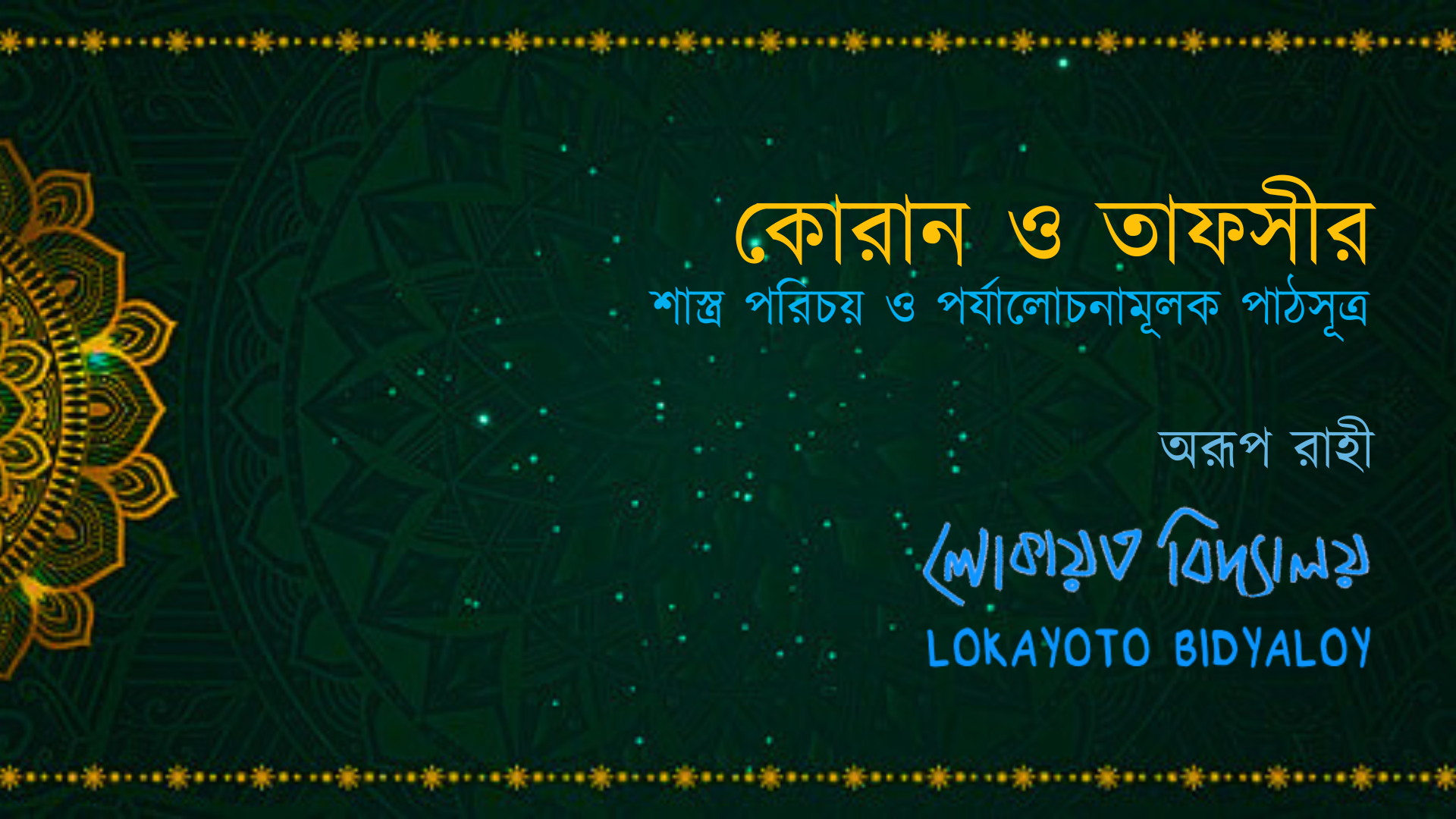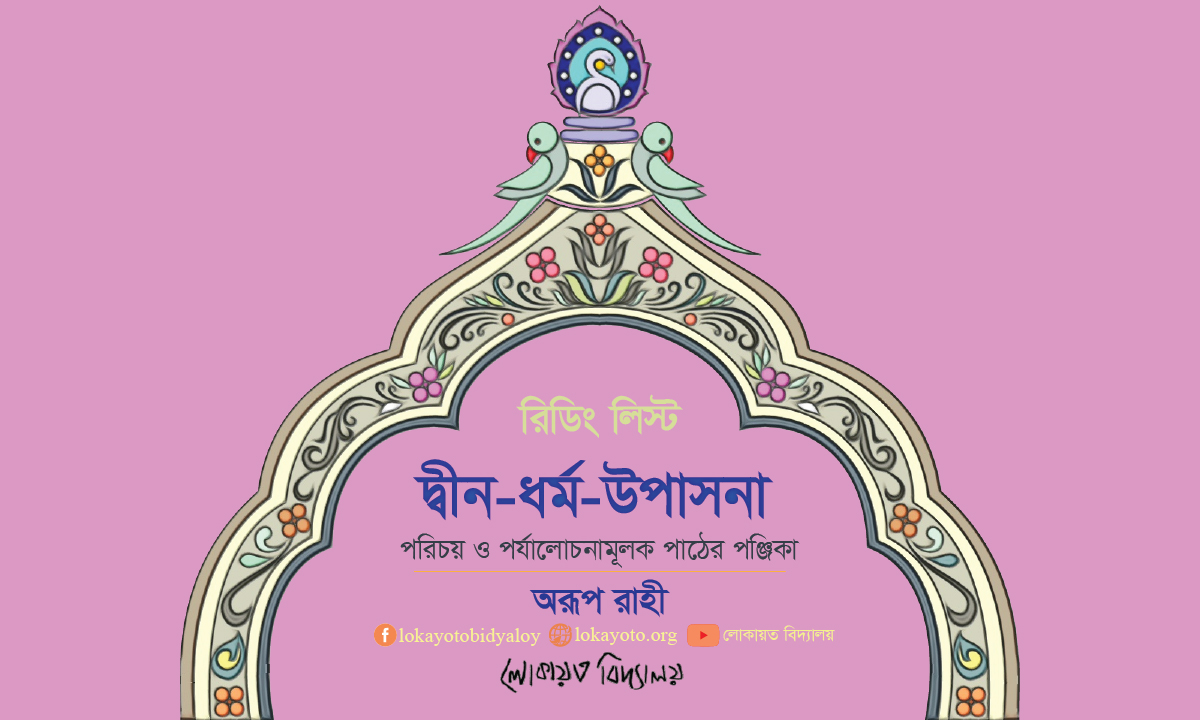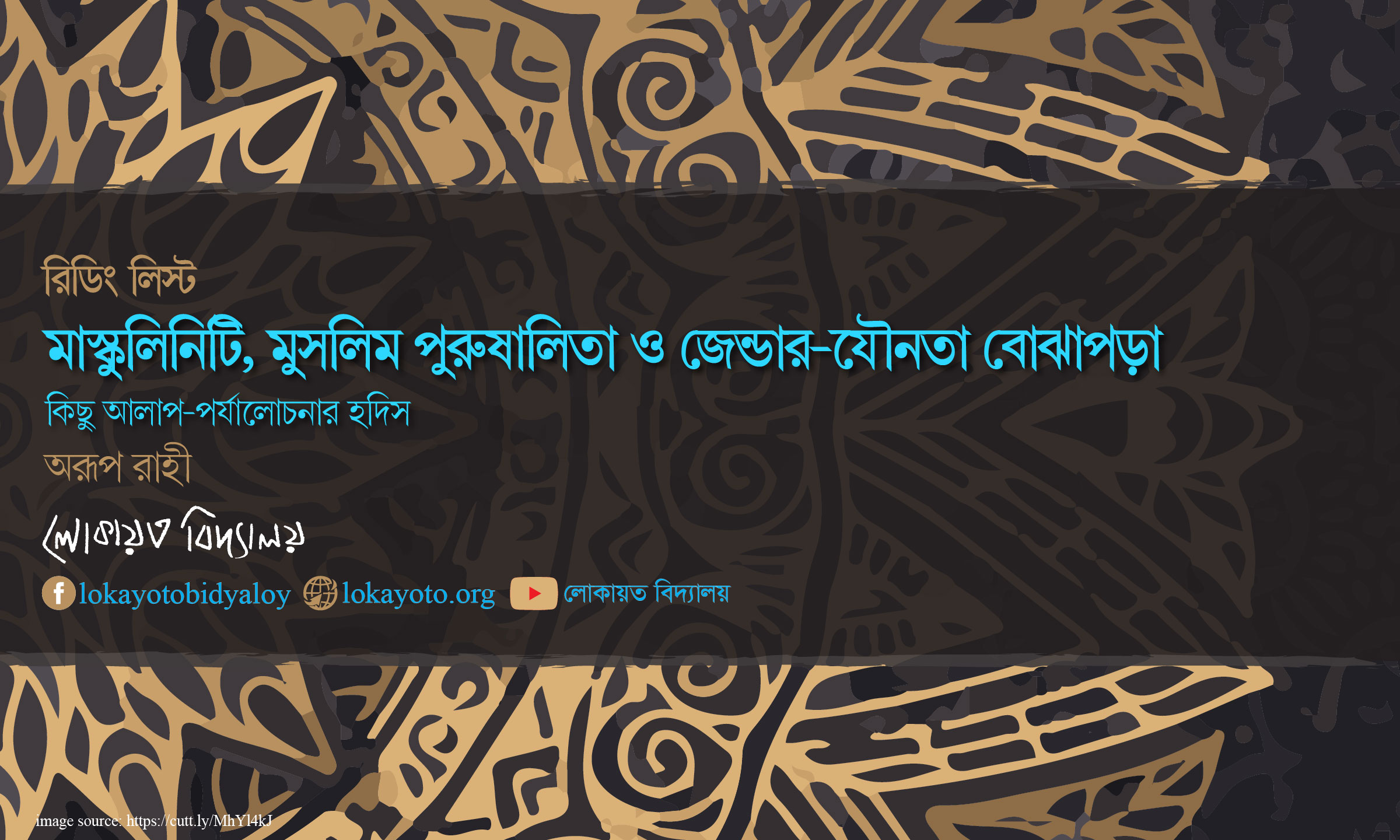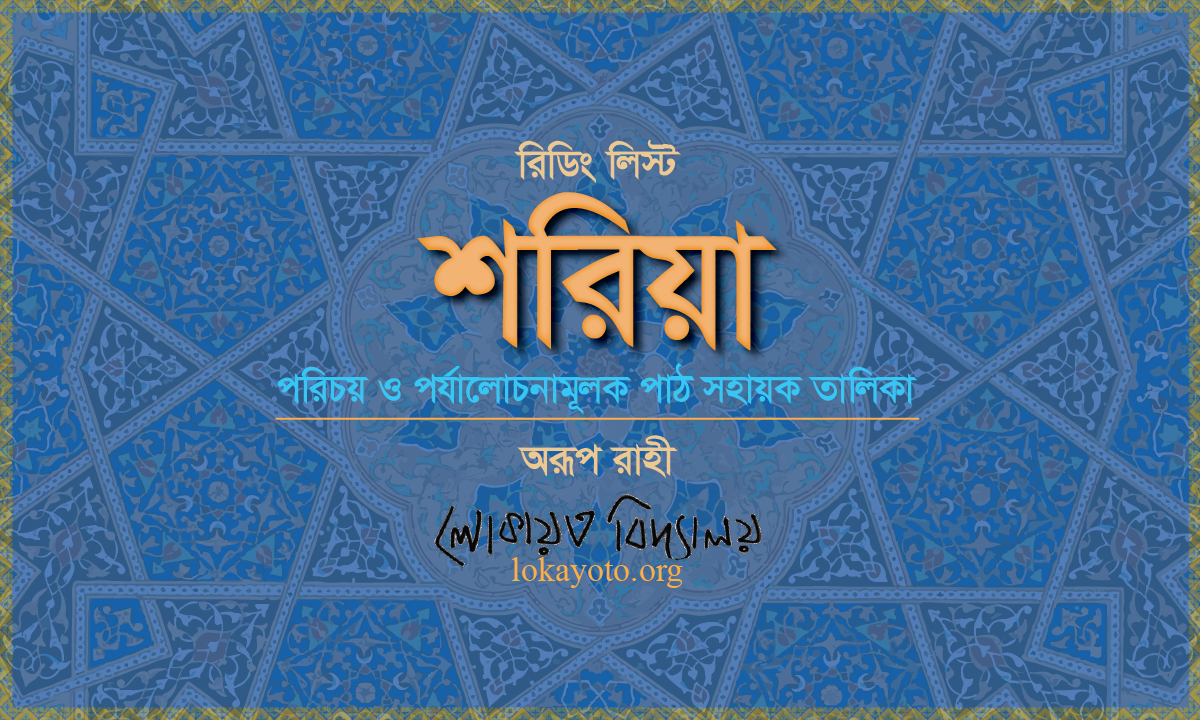
বাংলাদেশঃ উদারনীতিবাদী গণতন্ত্রের ফাঁদ এবং বিউপনিবেশিক বিকল্প ।। অরূপ রাহী
June 11, 2020
‘আমরা রূপান্তর প্রক্রিয়ার মধ্যে আছি’।।আব্দুল্লাহ আহমেদ আন-নাঈম
October 4, 2020‘প্রাচীনযুগের শেষভাগ’, ‘আল-জাহিলিয়া’ এবং ইসলামের আবির্ভাবকালের ইতিহাসঃ কয়েকটা বই ও প্রবন্ধের হদিস।।অরূপ রাহী
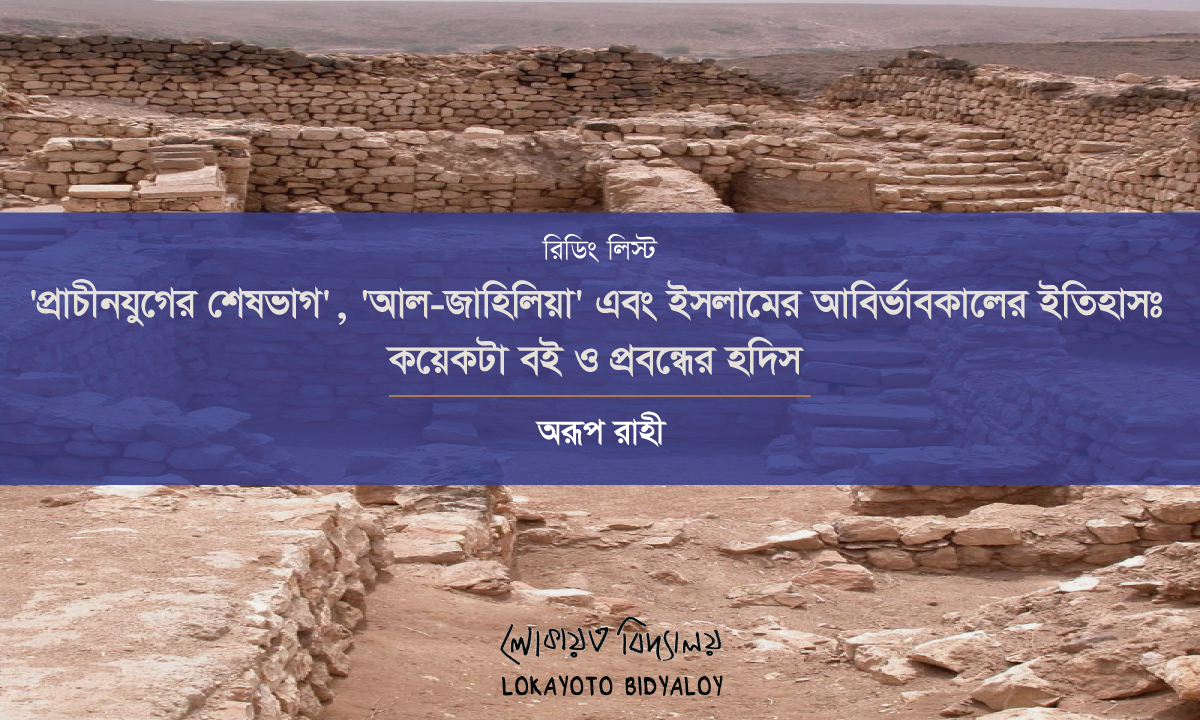
ভূমিকা
এখনো এই দেশে এমন অনেক মানুষ আছি আমরা, যারা সাবানের মোড়ক পথে পড়ে থাকতে দেখলেও তুলে পরিষ্কার করে সেটাকে পবিত্র জ্ঞানে চুমু খাই, যদি তাতে ‘আরবী’ হরফে কিছু লেখা থাকে- ‘নিশ্চয়ই আল্লাহ – রাসুল এর পবিত্র কোনো কালাম বা তাদের সম্পর্কে কোনো বাক্য/শব্দ লেখা আছে !’ – এমন ভাবনা থেকে এই কাজ করি আমরা। ‘আরবী’ ভাষা, ‘আরব’ এবং ‘ইসলাম’ সম্পর্কে আমাদের বহুমাত্রিক জ্ঞান- অজ্ঞানের একটা প্রকাশ হিসেবে এমন ঘটনাকে চিহ্নিত করতে পারি।
আমাদের সমাজে অতি সাম্প্রতিককাল পর্যন্ত ‘আরব’ , ‘জাহেলিয়া ‘ আর ‘ইসলাম’ সম্পর্কে– ‘ঐতিহাসিক জ্ঞান’এর প্রধান রসদগুলারমধ্যে আছে কোরান , বহুরকম হাদিস, কিছু হামদ– নাত, কিছু সিরাতুন্নবী; আছে ‘বিষাদ সিন্ধুর’ কারবালা– ফোরাত বর্ণনা, প্রাচীন পর্যটক আর মুসাফির/সুফি/ফকির পর্যটকদের বর্ণনার বাংলা রূপান্তর, আর ইরাক, পারস্য অঞ্চলের মনিষী–সাধকদের রচনা/কাহিনীর নানা রুপ ; আছে মাদ্রাসা ধরণের সকল শিক্ষা প্রতিষ্ঠানে আরবী চর্চা থেকে সমাজে যা যা কথ্য এবং লেখ্য রুপে এবং স্থানীয়– বৈশ্বিক প্রচার মাধ্যমে বাংলা বা অন্যান্য স্থানীয় ভাষায় যা যা আসে ।
এর বাইরে , কথিত ‘সেক্যুলার’ শিক্ষা/জ্ঞান ব্যবস্থায় / বাংলা ভাষায় ফিলিপ কে হিটি( Philip Khuri Hitti)র History of the Arabs এর প্রিন্সিপাল ইব্রাহিম খাঁ ‘র করা বাংলা অনুবাদ প্রথমে ‘ আরব জাতির ইতিকথা’ নামে এবং পরে ‘ আরব জাতির ইতিহাস নামে, ১৯৫৯ সাল থেকে বাংলাদেশে, বাংলা ভাষায় ‘আরব জাতি’র ইতিহাস বোঝার প্রধানতম একটা বইয়ে পরিনত হয়। হিটি এই বাংলা সংস্করণ প্রকাশের ভূমিকা লিখেন। বাংলা বইয়ের ‘অগ্র লেখা ‘ লিখে দেন ঢাকার মাদ্রাসা–ই–আলিয়ার মওলানা মুস্তাফিজুর রহমান, ১৯৫৮ সালে। সেকালের ইসলামিক একাডেমি প্রকাশ করে এই সংস্করণ।
এর বাইরে ৯/১১ পর্যন্ত বাংলায় ও বাংলাদেশে আরব, জাহেলিয়া এবং ইসলাম সম্পর্কে ‘জনপ্রিয়’ তেমন কোনো ইতিহাস বই নাই। । ৯/১১ এর পর সারা দুনিয়াতেই নতুন করে ইসলাম, আরব, মধ্যপ্রাচ্য, আব্রাহামিক ধর্মগুলার ইতিহাস এবং ধর্ম অধ্যয়ন শাস্ত্রের বিপুল পাঠ, অধ্যয়ন ও পর্যালোচনা শুরু হয়।
বাংলাদেশে ও বাংলাভাষাতে ইসলাম প্রসঙ্গে ইংরেজী ভাষা, পশ্চিম ও জনপ্রিয় পাঠ জগতের লেখক ও ইতিহাসকারদের জনপ্রিয় ধাচের রচনা অনুদিত হইতে শুরু করে। বাংলাভাষী/ বাংলাদেশের লেখকদের নিজস্ব রচনা লক্ষ্যনীয়ভাবে হাতে গোনা । তার দুই একটা বাদে বাকীগুলি অনেকেরই জরুরতের বিবেচনায় পাঠ তালিকা বহির্ভূত থাকবে।
৯/১১ এর আগেও, ৮০/৯০/০০ দশকে বিভিন্ন মধ্যপ্রাচ্যসহ বিভিন্ন অঞ্চলের সরকারী–বেসরকারী প্রকল্প সহযোগিতায় অনেক ‘ইসলামি লিটারেচার’ বাংলায় অনুবাদ হয়, যার ধারা এখনো প্রবহমান। কিন্তু সেসব অনুবাদের তালিকায় ‘পদ্ধতিগত ইতিহাস চর্চা’র জায়গা থেকে রচিত আরব/জাহেলিয়া/ইসলামের ইতিহাসের বই/আলাপ তেমন লক্ষ্য করা যায় না। কেন নাই– সেটার সামাজিক–ঐতিহাসিক পর্যালোচনা এই আলোচনার লক্ষ্য না। ‘পদ্ধতিগত ইতিহাসচর্চা’ই এখানে প্রশ্ন।
ইসলাম এবং ‘পদ্ধতিগত ইতিহাস’ চর্চার সম্পর্কও জটিল এবং বহুমাত্রিক। প্রথম সমস্যাঃ ‘ইতিহাস’ কী, ইতিহাসের ধারণা এবং চর্চার নানা মাত্রিক জটিলতা।
দ্বিতীয়তঃ ‘ইসলাম’-এর ঐতিহাসিকতার প্রশ্ন।
এই প্রশ্নের অন্তর্গত অনেক প্রশ্ন আছে, যেমনঃ
–ইসলাম কি ‘ইতিহাস সচেতন’ দ্বীন? কি কি ভাবে তা বুঝতে পারি আমরা?
– ‘ইতিহাস’ কি নিতান্তই পশ্চিম – ইউরোপীয় ‘সেক্যুলার’ ব্যাপার?
– ইতিহাস এবং ঐতিহাসিকতা প্রসঙ্গে দ্বীনি বুঝ কিভাবে নির্মিত হয়?
-‘ইসলাম’ কি নিজে ‘ঐতিহাসিক’, নাকি নিত্য–চিরন্তন? কোন মাত্রা ‘ঐতিহাসিক’ আর কোন মাত্রা ‘নিত্য চিরন্তন’?
–নিত্য–চিরন্তন হইলে নানা দেশকালে নবী–রাসুলগণের আবির্ভাব–তিরোভাব, তাদের মাধ্যমে বা উছিলায় বা উদাহরণে আইন–বিধান–বিশ্বাস পরিবর্তন–পরিবর্ধনের–পরিমার্জনের মধ্যে দিয়া যে সময়কল্প নির্মিত হয়– তার সাথে অপরাপর সময়ের ধারণা ও অভিজ্ঞতার মিল–পার্থক্য কী?
– সময়হীনতা, খোদায়ী সময়, খোদায়ী সময়ের নানা রূপক, বিশ্বচরাচরিক সময়, মানুষী সময়, সরলরৈখিক, বহুরৈখিক, চক্রাকার এবং পর্যায়ক্রমিক সময় কিভাবে আলাদা হয়? কী তার প্রক্রিয়া? এসববের বুঝ আমাদের কিভাবে তৈরি হয়?
–কোথায় কীভাবে ‘গল্প’– ‘পুরাণ’ – ’রূপকথা’-’কাহিনী’– ‘কাব্য’ আর ‘ঐতিহাসিক’ সময়ের পার্থক্য রচিত হয়?
– স্বাক্ষ্য, প্রমাণ এবং ভাষ্য–ব্যাখ্যার ব্যবহার, রূপক–তুলনা–অনুমান–শব্দবোধসহ বহুরকম প্রমানের ব্যবহার কেন চলে আসছে? জ্ঞান এবং প্রমাণ চর্চা কেন পরিহার করা যায় না? ব্যাখ্যা– ভাষ্য কেন বহু হয়? জ্ঞান এবং প্রমাণের সীমা কী? কিভাবে তা নির্ধারিত হয়? সামাজিক–ঐতিহাসিক–অভিজ্ঞতা- জ্ঞানের বিকাশ দিয়ে কী? ‘বয়ান’ ও ‘বয়ান’ নির্মান প্রক্রিয়া এসবে কিভাবে ভূমিকা রাখে? ইসলাম এবং এর ঐতিহাসিকতা বোঝার সাথে আরো অনেক প্রশ্নের সাথে এসব প্রশ্ন জড়িত।
‘বর্তমানে’র অভিজ্ঞতা ‘অতীতে’ প্রক্ষেপণ করে যেহেতু ‘অতীত’ বোঝা যায় না, তাই প্রশ্ন আসবেঃ বর্তমান বিভিন্ন প্রভাবককের প্রভাবে থেকে কি ‘ইসলাম’ এবং তার ‘ঐতিহাসিকতা’ বোঝা সম্ভব? এ প্রসঙ্গে প্রধান একটা প্রভাবকের আলাপ করতে পারি। তা হলো, পশ্চিমা–ঔপনিবেশিক আধুনিকতা এবং এনলাইটেন্মেন্ট। এনলাইটেন্মেন্ট এবং আধুনিকতা নিজে কোনো প্রথমত সমস্বত্ব ও এক রৈখিক ব্যাপার না। দ্বিতীয়ত, অন্য অনেক কিছুর মতো ‘ইসলামের’ও অবদান আছে ‘এনলাইটেন্মেন্ট’-এ।
তো, এই আধুনিকতা ও এনালাইটেম্নেট–এর জ্ঞানবলয়ে( প্রাচ্যবাদ তার উদাহরণ) থাকার অভিজ্ঞতা অ–পশ্চিমা ‘অতীত’ বুঝতে–পাঠ করতে কি কি সমস্যা করে? সেসব সমস্যা থেকে মুক্ত হয়ে ‘অতীত’ দেখার–বোঝার উপায় কী?
আবার, পশ্চিমা আধুনিকতার এই বিপুল প্রভাবশালী অভিজ্ঞতার (আধুনিক পুজিবাদ, শিল্প সভ্যতাজাত সময় আর যোগাযোগ অভিজ্ঞতা, জ্ঞানব্যবস্থা, ইন্দ্রিয় ও সংবেদনগুলোর বিকাশ ও পরিবর্তন) দিকগুলা বিবেচনা করে নতুন করে অতীত/নিজেদেরকে দেখার এই পর্বকে কোন সময় হিসেবে চিহ্নিত করবো?
কারন, ইতিমধ্যেই, দ্বীন, ধর্ম, উপাসনা, কৃষ্টি, কালচার, তমুদ্দন, বিজ্ঞান, প্রযুক্তি, সংস্কৃতি– জলবায়ু– মানুষ– প্রানী– বিশ্বচরাচর বোঝার–চেনার ‘ইতিহাস’ আমাদের জ্ঞাত–অজ্ঞাতসারে বিপুল পরিবর্তনের মধ্য দিয়া গেছে বা যাইতেছে। চাইলেও সেই ‘আদর্শ’ বা ‘ সোনালী’ বা ‘গৌরব ‘ বা ‘ জয়’ বা ‘পরাজয়’ কালের মত করে কিছুই আর দেখা সম্ভব না।
এসব বিবেচনায় রাখলে প্রশ্ন করা যায়– জাহেলিয়াত কী? ‘জাহেলিয়াত’ কি একমাত্রিক সময় বা ঘটনা? জাহেলিয়াত কিভাবে সাব্যস্ত হয়? একালে আর সেকালে জাহেলিয়াতে অর্থ–ব্যঞ্জনার পার্থক্য কী ও তা কিভাবে ঘটে? ‘ইসলাম’ আর ‘জাহিলিয়াত’ নানান দেশ-কালে কোন প্রক্রিয়ায় আলাদা হয়? তার সামাজিক–তমুদ্দনিক–দেশকালগত বৈশিষ্ট কিভাবে চিনহিত করা যায়? প্রাচীন যূগের শেষ ভাগ(Late Antiquty) এবং জাহিলিয়াত বোঝার চ্যালেঞ্জগুলা কী?
আরব অঞ্চল, সেমেটিক অঞ্চল, প্রাচীন রোমান সাম্রাজ্যসহ অন্যান্য অঞ্চলের নানামাত্রিক দ্বীন– দুনিয়া অভিজ্ঞতা কিভাবে ইসলামের আবির্ভাবের প্রেক্ষাপট রচনা করলো? সেসবের কি কি , কেন, কোন কোন প্রক্রিয়ায় ‘ইসলামের’ মধ্যে আসা যাওয়া করলো?
‘আরব’ পরিচয় কিভাবে বিকশিত হইলো ‘আরব’ অঞ্চলে? ‘আরব’ পরিচয়ের সাথে ইসলামের সম্পর্ক এবং পার্থক্য কী?
‘ইসলাম’ কী ভাব-বস্তু কাল–কালান্তরে? কাল, কালপর্ব বিভাজনের তরিকাই বা কী হবে– যা ন্যায়–ইনসাফ–প্রজ্ঞাপুর্ণ? কাল এবং কালান্তরগুলা বুঝার উপায়–নিশানা কী? দেশ–দেশান্তরে, কালে–কালান্তরে, ভাষা–ভাষান্তরে কি একই ভাববস্তুতে ইসলামকে বুঝতে পারে মানুষ এবং নানান সমাজ? ছিলো কখনও এমন?
এসব নিয়ে দুনিয়ায় বহু মত, বুঝ ও ব্যাখ্যা হাজির হওয়া সম্ভব, হচ্ছেও তাই। বিভিন্ন বুঝ হাজির হবার এই সম্ভাবনা, এই বাস্তবতা এবং এই ‘ইতিহাস’ নিজেও কি ইসলামের ইতিহাস নয়– বড় এবং অপরিহার্যভাবে?
এই সব প্রশ্ন এবং সমস্যা ঘিরেই ইসলাম ও তার ‘ইতিহাস অধ্যয়নের নানান ধারা, ঘর ও ঘরানা বিকশিত হইছে দুনিয়ায়। বিকশিত হইতেছে ‘ইসলামের ইতিহাস’ এবং ইতিহাস শাস্ত্রের ইসলামিক রীতি–পদ্ধতিরও নানা ট্র্যাডিশন।
‘সেক্যুলারিস্ট’/ ওরিয়েন্টালিস্ট/ “এন্টি–সেক্যুলার”/ ‘রিলিজিয়াস’/ পরিচয়বাদ ইত্যাদি সমস্যাজনক বাইনারী এবং জুলুমকারী বিভাজন পদ্ধতির বাইরে বের হয় ইতিহাবিদ্যা , ইসলামের ইতিহাস চর্চার তদবির জারি আছে দুনিয়ায়। তার কিছু প্রায়োগিক উদাহরণ এবং প্রয়োগ পদ্ধতির আলাপ সমৃদ্ধ বই–প্রকাশনা–দলিল ইতোমধ্যে হাজির হইছে দুনিয়ায়, নানান ভাষায়। বাংলাসহ এই অঞ্চলের স্থানীয় ভাষায় এসবের চর্চা তেমন লক্ষ্য করা যায়না– আফসোস।
তো, এই বহুপ্রজ্ঞার উন্মেষ কি পরম করুণাময়ের রহমত না? পরম করুণাময় আমাদের সেই রহমত অর্জন ও ধারণ করার তৌফিক দিন। ইসলামের যেমন বুঝ আমাদের পরিচয়বাদী/জাতিবাদী , শ্রেষ্টত্ববাদী, পুরুষতান্ত্রিক, পুঁজিবাদী , বর্ণবাদী জুলুম– জুলুমশাহী থেকে মুক্ত রাখতে পারে– তেমন বুঝ বুঝার তৌফিক দিন।
এখানে আমরা ইসলামের আবির্ভাব কালের ইতিহাস ও ঐতিহাসিকতার নানা মাত্রা, সেসব মাত্রা বোঝার কায়দা–পদ্ধতি, চ্যালেঞ্জ এবং ইতিহাস রচনা পদ্ধতির আলাপ সমৃদ্ধ কিছু কিতাবাদির তালিকা করলাম, আমার নিজের এবং আগ্রহী পাঠকের সুবিধার্থে।
এই তালিকা প্রণয়নের সময়ে মোহাইমিন লায়েছ, জাকারিয়া হোসাইন অনিমেষ ও মিথিলা মাহফুজের সাথে আলাপ–আলোচনা–পরামর্শ করে উপকৃত হইছি। তাদেরকে ধন্যবাদ। তবে এখানে ভুল–ভ্রান্তি–সীমাবদ্ধতার সব দায় আমার।
তালিকা দেখে–পড়ে উৎসাহী হয়ে যদি কেউ কেউ নতুন ভাবনা, অনুসন্ধান, পর্যালোচনা, রচনা বা অনুবাদে উদ্যোগী হন, দ্বীনের খেদমত হিসেবে তা পরম করুণাময় নিশ্চয়ই কবুল করবেন, সেই উছিলায় পরমের করুণা সিন্ধুর বিন্দু হলেও পাবো এই দীনহীন – এই আশা অন্তরে।
অরূপ রাহী। আষাঢ়, ১৪২৭। জুন, ২০২০।
##
তালিকা ও পাঠপদ্ধতি প্রসংগে গৎবাঁধা আলাপঃ
মনে রাখতে হবে– এই তালিকা নির্মাণটা নানাদিক থেকে সীমাবদ্ধ কিন্তু চলমান। এতে যোজন–বিয়োজন ও পরিমার্জন চলতে থাকবে। যেসব জিনিসপত্রের নাম দেয়া আছে– তার সব অগ্রাধিকার ভিত্তিতে সাজানো আছে– এমন না। সহজ–কঠিনের ক্রমানুসারেও সাজানো নয় এই তালিকা। এসবই পাঠকের বিবেচনা ও অগ্রাধিকারের আওতায়।
তালিকাটা প্রাথমিক একটা সুত্র হিসেবে হাতে রেখে পড়াশুনা করতে গিয়ে পাঠক নিজেই তার নিজের অগ্রাধিকার পাঠের তালিকার দিকে যেতে পারবেন বা যাবেন বলে আশা করি।
পরামর্শ থাকবে– একটা বা দুইটা কোনো জিনিস পড়ে–শুনে সিদ্ধান্ত বা মত চুড়ান্ত না করার। ভিন্নমতগুলির সাথে চেনা–জানার চেষ্টা খুব কাজের। এটা বিবেচনায় রেখে চেষ্টা আছে এই তালিকা যথাসম্ভব ভারসাম্য ও পর্যালোচনামূলক রাখার। কোনো মত বা সিদ্ধান্ত প্রস্তাব করা বা চাপিয়ে দেয়া এই তালিকার উদ্দেশ্য নয়। বরং, একটা সামগ্রিক পর্যালোচনার তদবির যেন সমাজে চলে– সেটা এই তালিকা করার প্রধান উদ্দেশ্য।
তালিকায় উল্লেখ করা এই পর্যায়ে সম্ভব হচ্ছে না, কিন্তু, একেক রচনার/টেক্সটের একেক রচনা সময়, অঞ্চল বা প্রেক্ষিত। তার আগে পরে, বিভিন্ন অঞ্চলে সে বিষয়ে আরো অনেকের অনেক কাজ থাকতে পারে বা আছে– সেসবের সাথে পরামর্শ করা জরুরী, তা না হলে কোনো রচনার ওপর অবিচার করা হয়ে যাইতে পারে।
তালিকাঃ
১। ইসলাম ও ইতিহাসলিখনবিদ্যা( historiography)
ইসলামিক ইতিহাসলিখন( historiography) শাস্ত্র পরিচয়ঃ
Islamic Historiography.
Chase F. Robinson.
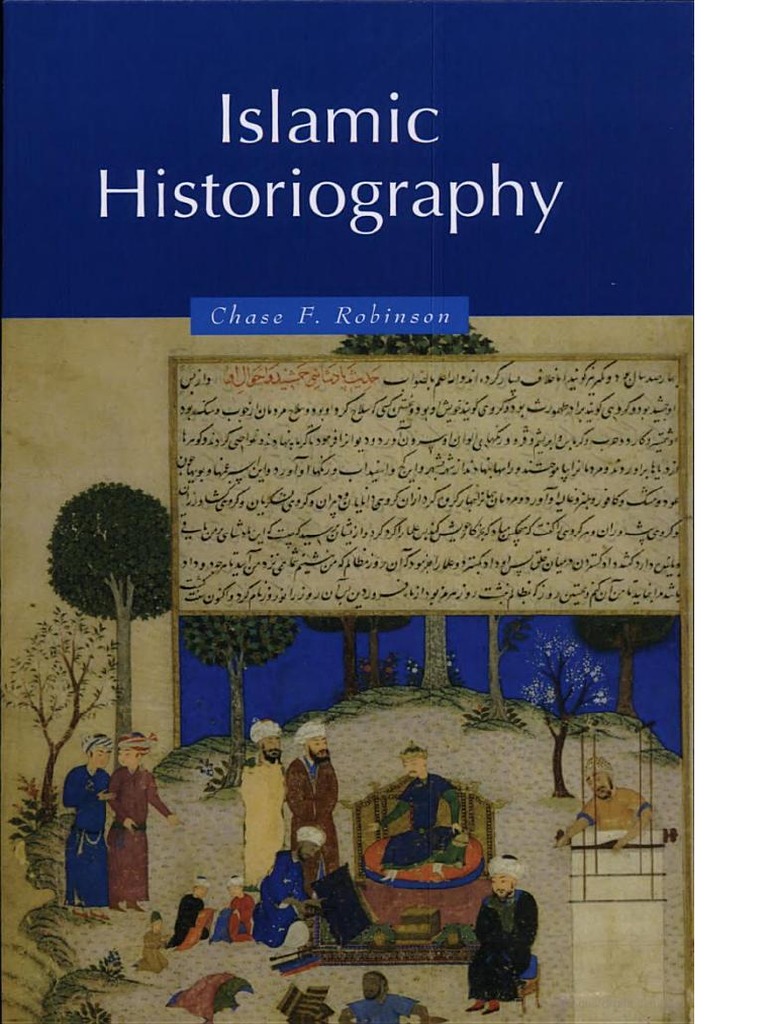
Preface
Part I. Origins and Categories:
1. Origins 2. The emergence of genre 3. Consequences and models 4. Three categories: biography, prosopography, chronography
Part II. Contexts:
5. Historiography and traditionalism 6. Historiography and society 7. God and models of history 8. Historians and the truth
Part III. How Historians Worked:
9. Vocations and professions 10. Writing history
Conclusion
Suggestions for further reading
Bibliography
_________________________________________
Islamic Methodology in History
Fazlur Rahman
1965
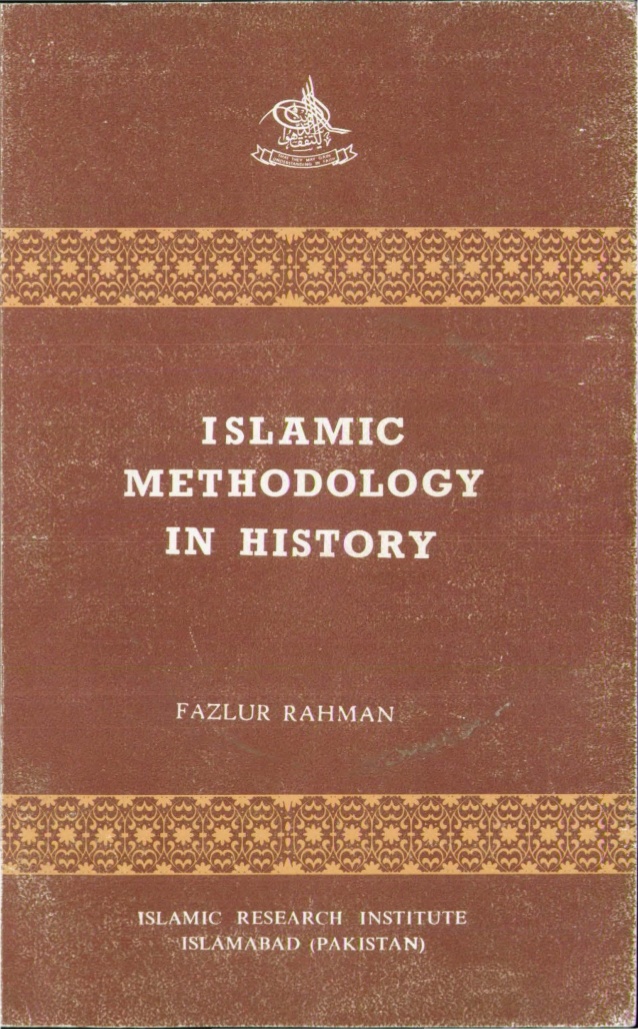
- Concepts Sunnah, ljtihad and lima’ in the Early Period ;
- · Sunnah and l;Iadith
- Post-Formative Developments in Islam ;
- 1 itihad in the Later Centuries ..;
- Social Change and Early Sunnah .
- BIBLIOGRAPHY .
_________________________________________
ইসলামিক ইতিহাসলিখনবিদ্যার পর্যালোচনাঃ
বই-
Islamic Historiography: The Histories of Mas’udi.
Tarif Khalidi . 1975

Introduction, List of Abbreviations,
1. Sources and Style/ Range of Sources/
The Historian’s Craft/ History and adab/ Mas’udi’s Style/ The isnad.
2. Reflections on Historical Method/ Reasons for Reflecting on History/ The Background: History/ Theology and the Natural/ Sciences/ The Value of History/ The Modes of Apprehension/
Nature and the Supernatural/ The Concept of bahth.
3. Divine and Natural Factors in Human History/ Introductory Remarks/ The Creation of the World/ Prophecy and Prophets/ Natural Religion: Reason and Revelation/ Nature and Society/ Religion and Kingship/ The Sources of Mas’údi’s Views.
4. The Ancient Nations/ The Ancient Nations and Islam/ Genealogy of Ancient Nations/
The Seven Ancient Nations/ Patterns in the History of Ancient Nations/ The Problem of Progress.
5. The Pre-Islamic Arabs and Islam/ General Problems/ Pre-Islamic Arabia/ The Prophet’s Life/ The First Four Caliphs/ The Umayyads/ The Abbasids/ Mu’tazilism and Shi’ism/ Conclusion.
Appendixes/ A. Fragments of a Biography/ B. Reconstruction of Lost Works
_________________________________________
Arabic Historical Thought in the Classical Period
Tarif Khalidi. 1994
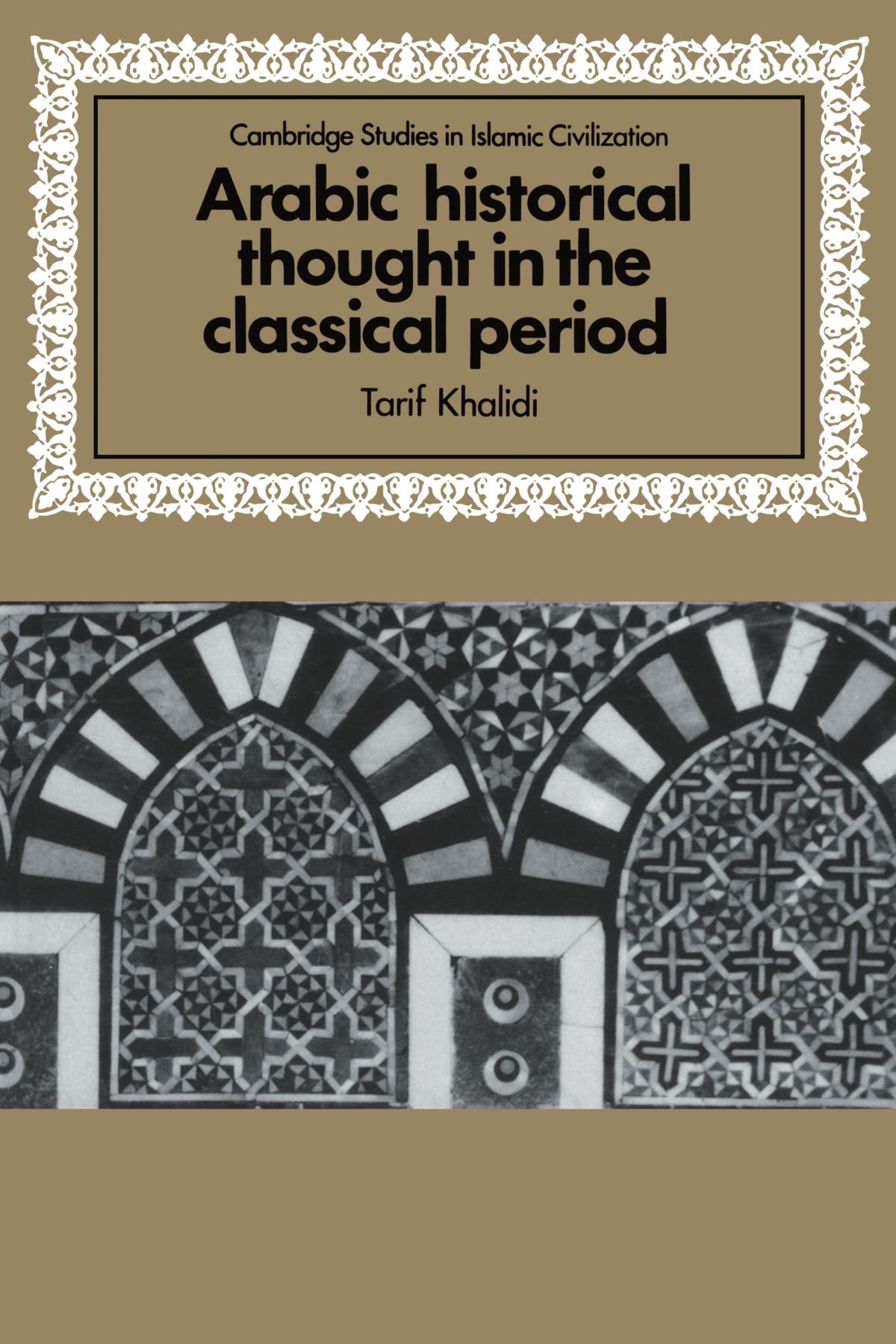
Table of Contents
- The birth of tradition
- History and hadith
- History and adab
- History and hikma
- History and siyasa Conclusion.
_________________________________________
The Times Of History: Universal Topics in Islamic Historiography
Aziz Al-Azmeh। 2007.
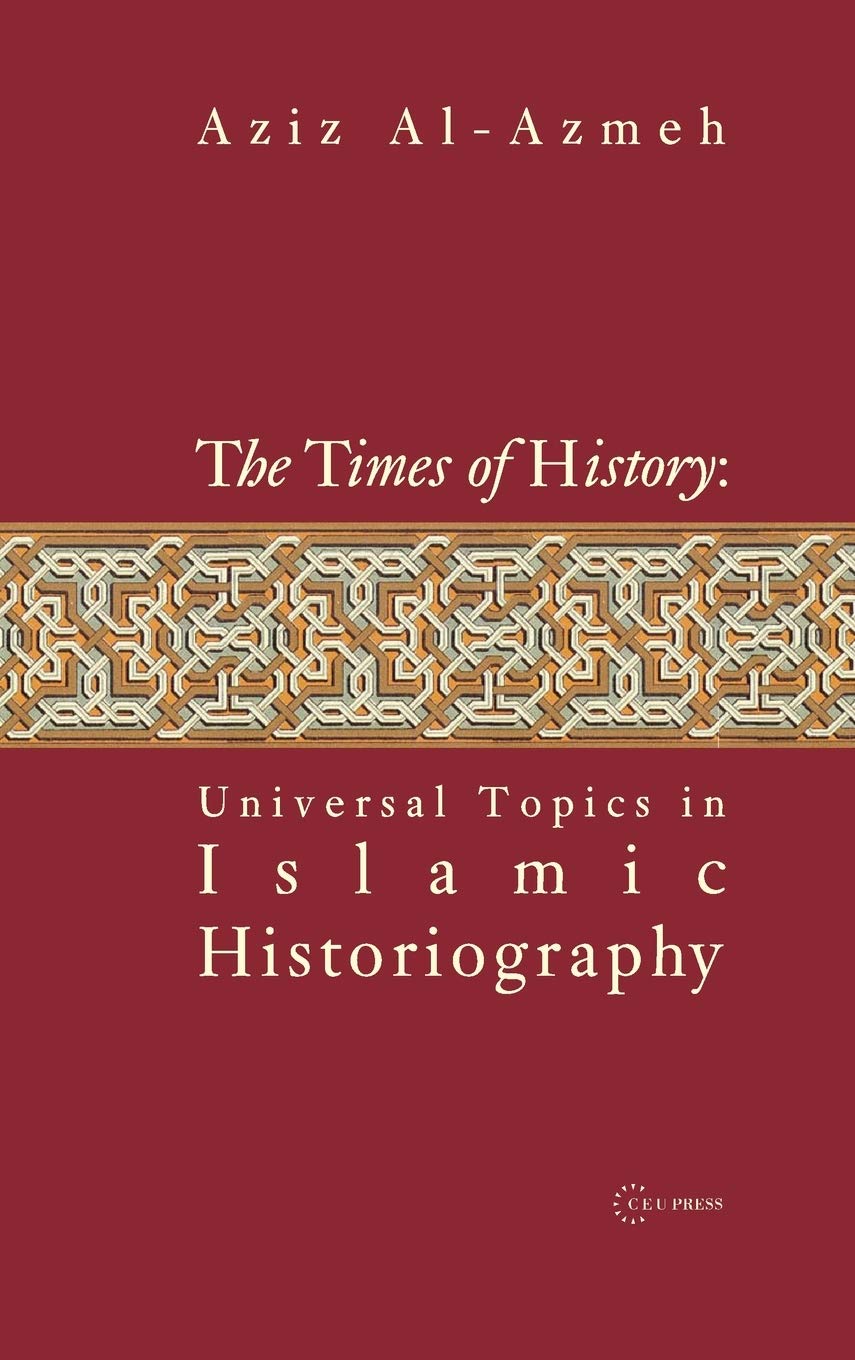
content:
- Historical categorization
- Tropes and temporalities of historiographic romanticism, modern and Islamic
- Islam and the history of civilizations
- Typological time, patterning and the past appropriated
- Chronophagous discourse: a study of the clerico-legal appropriation of the world in an Islamic tradition
- The muslim canon from late antiquity to the era of modernism
- History of the future
- God’s chronography and dissipative time
- Rhetoric for the senses: a consideration of Muslim paradise narratives
- Distractions of Clio: impasses and perspectives of historians’ history
- Islamic political thought: current historiography and the frame of history
- Monotheistic monarchy
_________________________________________
২/ আল- জাহিলিয়া / জাহিলিয়াত
প্রবন্ধঃ
Al-Jāhiliyya: Uncertain Times of Uncertain Meanings.
Peter Webb
-Al-Jāhiliyya: development of the paradigm
-Al-Jāhiliyya and Arabic lexicography
-Al-Jāhiliyya in Qurʾān commentaries
-Al-Jāhiliyya in third/ninth century discourses on Arabness
-The “meritorious” al-Jāhiliyya?
বই
Islam and its Past: Jahiliyya, Late Antiquity, and the Qur’an.
Edited by Carol Bakhos and Michael Cook
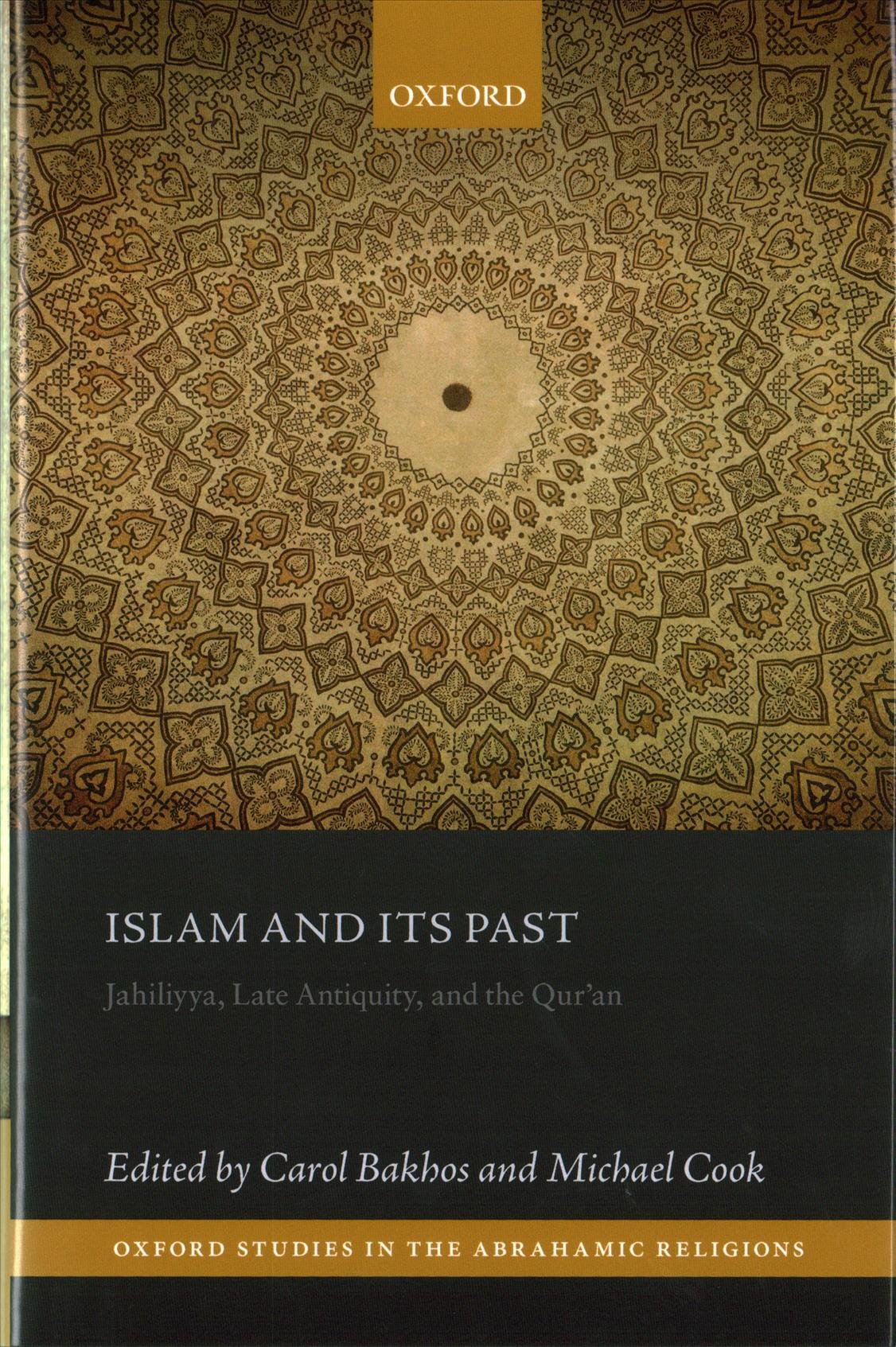
Introduction, Carol Bakhos and Michael Cook
1: Reflections on the State of the Art in Western Quraanic Studies
2: Processes of Literary Growth and Editorial Expansion in Two Medinan Surahs. Nicolai Sinai
3: O Believers, Be not as Those who Hurt Moses : Q 33:69 and its Exegesis. Joseph Witztum
4: Pagan Arabs as God-fearers. Patricia Crone
5: Locating the Qur’an and Early Islam in the Epistemic Space of Late Antiquity. Angelika Neuwirth
6: Were there Prophets in the Jahiliyya? Gerald Hawting
7: Early Medieval Christian and Muslim Attitudes to Pagan Law: a Comparison. Michael Cook
8: Remarks on Monotheism in Ancient South Arabia. Iwona Gajda
_________________________________________
৩/ ‘আরব’ কী ব্যাপার
বই-
Imagining the Arabs: Arab Identity and the Rise of Islam.
Peter Webb
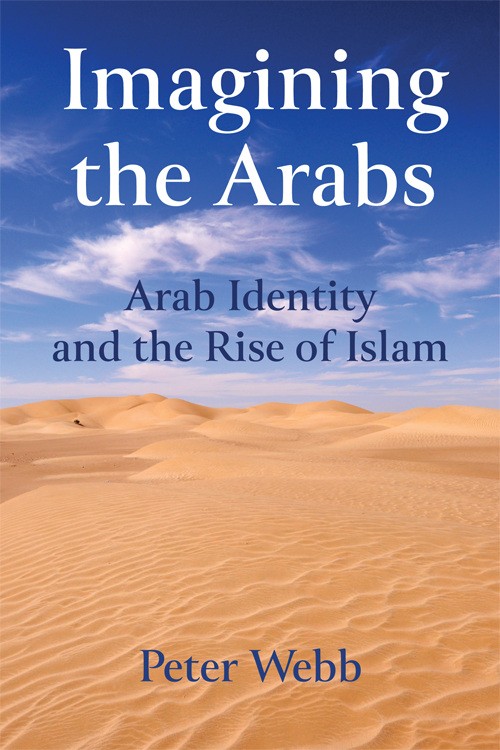
Note on the Text
Introduction
Part 1: The Rise of Arab Communities
- The Rise of Arab Communities
- Arabs and pre-Islamic Textual Traditions
- Arabs in Arabia: ethnogenesis, interpretations and problems
III. An Arabness pretence: pre-Islamic ‘Arab’-cognates reconsidered
- Pre-Islamic ‘Arabless-ness’: Arabian Identities
- The Arabic Language: a signpost to Arabness?
- The search for Arabs in pre-Islamic poetry
III. Contextualising the ‘Arabless’ Poetry: ethnic boundaries in pre-Islamic Arabia
- The rise of ‘Arab’ poetry
- Transition from ‘Maʿadd’ to ‘Arab’: case study of Dhū Qār
- Pre-Islamic Arabian identity: conclusions
- Arabness from the Qur’an to an ethnos
- ‘Arab’: an ethnonym resurrected?
- The Qur’an and Arabness
III. Early Islam and the genesis of Arab identity
Part Two: The Changing Faces of Arabness in Early Islam
- Interpreting Arabs: defining their name and constructing their family
- ‘Arab’ defined
- Arabness and contested lineage
III. Arab genealogy reconsidered: kinship, gender and identity
- The creation of ‘traditional’ Arab genealogy
- Defining Arabs: conclusions
- Arabs as a people and Arabness as an idea: 750-900 CE
- Arabs in the early Abbasid Caliphate (132-193/750-809)
- Forging an Iraqi ‘Arab Past’
III. al-Jāhiliyya and imagining pre-Islamic Arabs
- Arabs and Arabia: changing relationships in the third/ninth century
- Philologists, ‘Bedouinisation’ and the ‘Archetypal Arab’ after the mid-third/ninth century
- Philologists and Arabness: changing conceptions of Arabic between the late second/eighth and fourth/tenth centuries
- The transformation of Arabness into Bedouin-ness
III. Bedouin Arabness and the emergence of a Jāhiliyya archetype
- Conclusions
Imagining and Reimagining the Arabs: Conclusions
Bibliography.
_________________________________________
৪/ প্রাচীনযুগের শেষভাগঃ আব্রাহামিক ধর্মগুলা
বই-
The Making of the Abrahamic Religions in Late Antiquity
Guy G. Stroumsa
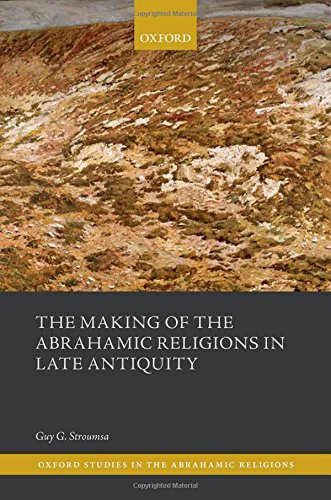
Introduction: From Qumran to Qur’an: The Religious Worlds of Late Antiquity
Part I: Transformations of Religion in Late Antiquity
1: The End of Sacrifice
2: Patterns of Rationalization
Part II: The True Prophet
3: False Prophets of Early Christianity
4: False Prophet and False Messiah
5: Seal of the Prophets
Part III: Religious Communities and God’s Law
6: Religious Dynamics between Jews and Christians
7: God’s Rule in Late Antiquity
Part IV: The Way to Mecca
8: Jewish-Christians and Islamic Origins
9: Christian Memories and Dreams of Jerusalem
10: Barbarians or Heretics?
Envoi: Athens, Jerusalem, Mecca: praeparatio coranica
_________________________________________
৫/ ‘প্রাচীনযুগের শেষভাগে’ ‘ইসলাম’
বই-
The Emergence Of Islam In Late Antiquity / Allah And His People .
Aziz Al-azmeh
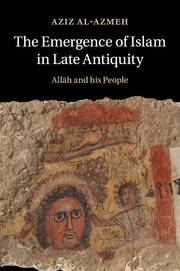
- Late antiquity and Islam: historiography and history
- Gods, divine economies, and emperors
- Arabia and Arab ethnogenesis in late antiquity
- Preface to Allah
- Allah
- Paleo-Islam, 1: charismatic polity
- Paleo-Islam, 2: the Paleo-Muslim canon
- Retrospective and prospective: Islam in late antiquity and beyond.
_________________________________________
বই-
The Social Origins Of Islam: Mind, Economy, Discourse .
Mohammed A. Bamyeh

Contents:
Introduction
Part I: The Ground one.
The Ideology ofthe Horizons
Horizon,Vision,Settlement—Halting and Discourse—The Camel,
the Path,and the Marketplace
two. Socioeconomy and the Horizon ofThought
Sedentarization—Money,Trade,and Abstract Thought—Mecca—
The Nomadic Flux—Kinda
three. Social Time,Death,and the Ideal
Rendering the Experience—Idealization and the Past—Mortality and the
Future—Waiting
four. Pre-Islamic Ontotheology and the Method ofKnowledge
Paganism and the Idea ofthe Ritual—Reformers,Hanifism,Pagan
Monotheism—Examples and Commentary
five. The Discourse and the Path
Forms,Codes,Words—Nature,Text,Ruins—The Wandering Logic—
Sources ofStructural Stability
Part II: The Faith
six. Prophetic Constitution
The Land Dreams ofa Prophet—Constitution ofSagehood: Knowledge,
Foreknowledge—The Tear ofthe Poet and the Fear ofthe Prophet: Failures
ofBelonging
seven. The House ofthe Ummaand the Spider Web ofthe Tribe
The Tribe—The Ruins ofthe Tribe—Fitnah,Hijra,War—The Satanic
Verses and Their Background—The Boundaries ofthe Umma—
Hudaybiyyahand the Paradigms ofthe Umma
eight. Austerity,Power,and Worldly Exchange
Death,Subjectivity,and Identity—Austerity,Justice,Perishing: Moses and
‘Ubayd—God’s Contracts—War and the Code ofJustice—Fate and the
Legitimacy ofAcquisition
nine. In Lieu ofa Conclusion:The Origins,the System,and the
Accident 257
Notes
Bibliography
Index
_________________________________________
বই –
Remapping Emergent Islam: Texts, Social Settings, and Ideological Trajectories
Carlos A. Segovia (ed.)
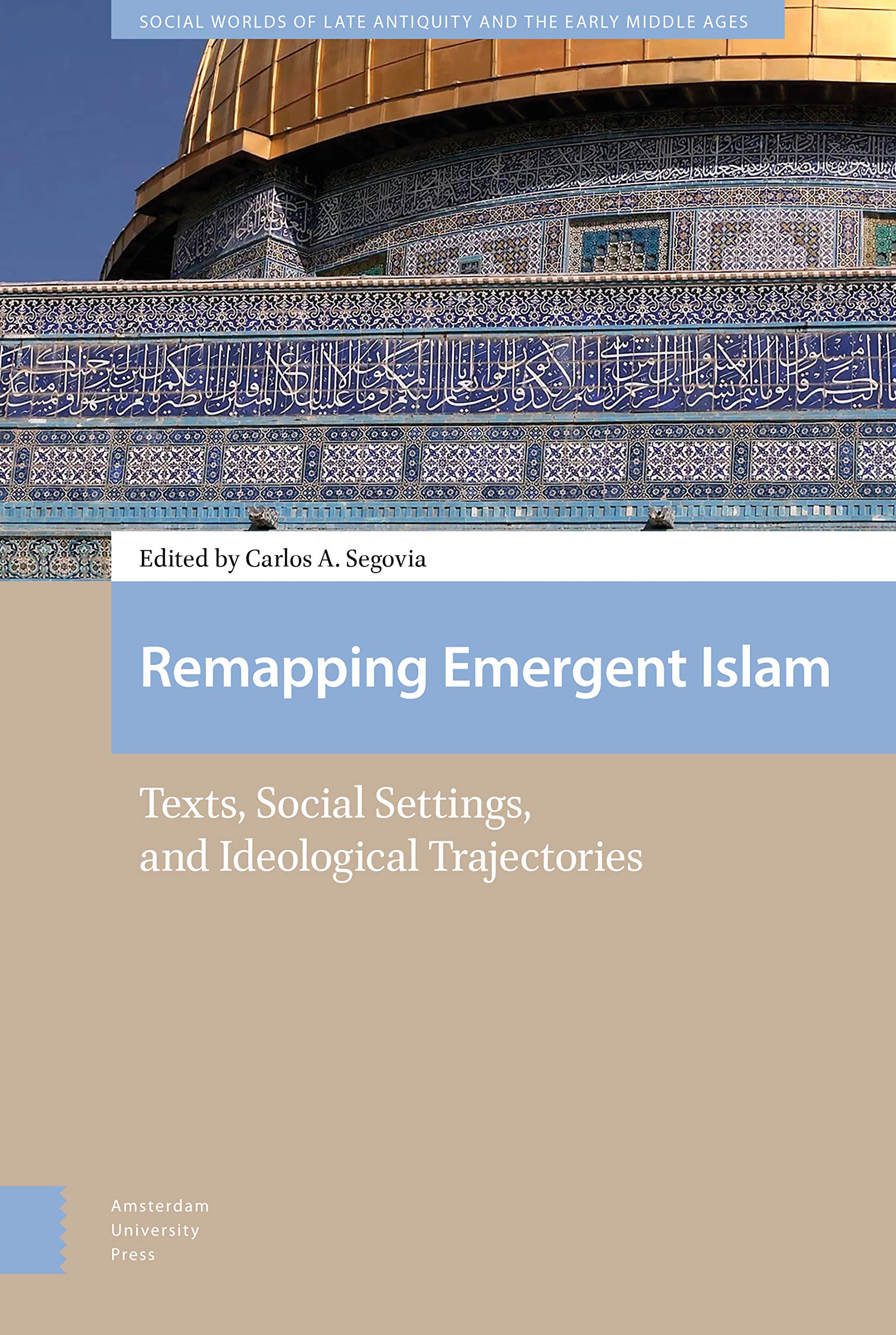
Table of Contents
Introduction . Carlos A. Segovia
Part 1 Re-Assessing the Hypothesis of a Peripheral Jewish Background
- South Arabian ‘Judaism’, Ḥimyarite Raḥmanism, and the Origins of Islam. Aaron W. Hughes
- Early Islam as a Messianic Movement: A Non-Issue? . José Costa
Part 2 An Encrypted Manichaean / Messalian Matrix?
- The Astral Messenger, The Lunar Revelation, The Solar Salvation : Dualist Cosmic Soteriology in The Early Qur’ān . Daniel A. Beck
- Messalianism, Binitarianism, and the East-Syrian Background of the Qur’ān . Carlos A. Segovia
Part 3 Measuring the World’s Timeline… and Imagining the Afterlife at the Persian Court?
- The Jewish and Christian Background of the Earliest Islamic Liturgical Calendar . Basil Lourié
- The Persian Keys of the Quranic Paradise . Gilles Courtieu
Part 4 Conceptual Quicksand, Meta-Narratives of Identity, Texts and their Marginalia
- Divine Attributes of ‘Alī in Shi’ite Mysticism : New Remarks on ‘Heresy’ in Early Islam . Mohammad Ali Amir-Moezzi
- Echoes of Pseudepigrapha in the Qur’ān . Tommaso Tesei
- What Do We Mean by THE Qur’ān: On Origins, Fragments, and Inter-Narrative Identity. Emilio González Ferrín
_________________________________________
৬। ‘প্রাচীনযুগের শেষভাগ’এর পুনর্বিবেচনা
বই-
Before and After Muhammad: The First Millennium Refocused
Garth Fowden
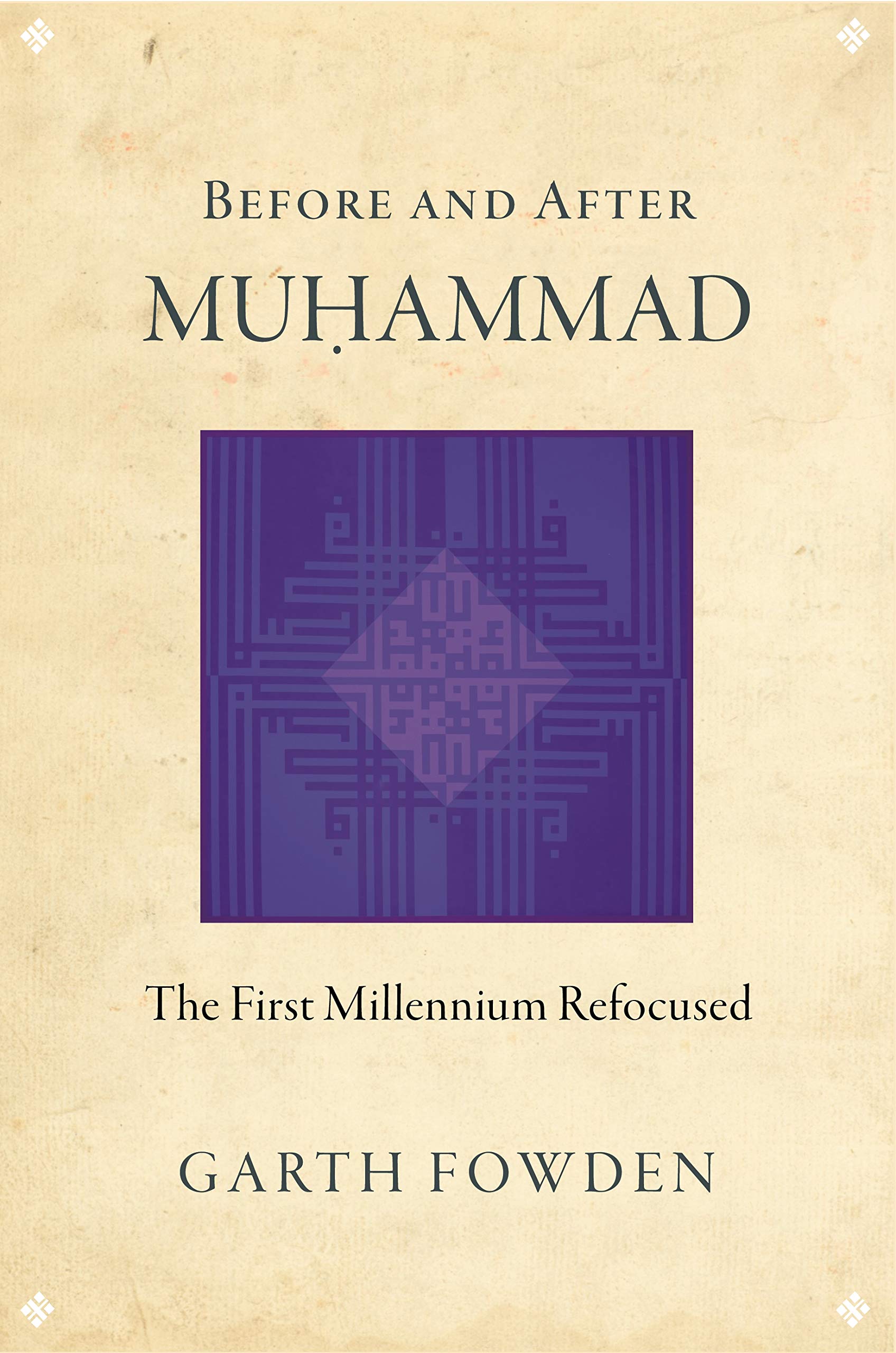
Table of Contents
Prefatory Note and Acknowledgments ix
Abbreviations xi
Chapter 1. INCLUDING ISLAM
The West and the Rest
Edward Gibbon
Islam and late Antiquity
Summary
Chapter 2. TIME: BEYOND LATE ANTIQUITY
The roots of late antique studies
Burckhardt to Strzygowski
The Orient and Islam: Views from Vienna
Pirenne to the present
Chapter 3. A NEW PERIODIZATION: THE FIRST MILLENNIUM
Decline versus transformation
Maturations
Monotheist historiography
For and against the First Millennium
Chapter 4. SPACE: AN EASTWARD SHIFT
Discovering the Mediterranean
Discovering the East
Empires and commonwealths
The Mountain Arena
Chapter 5. EXEGETICAL CULTURES 1: ARISTOTELIANISM
Greek Aristotelianism
Christian polemic
Aristotle in Latin, Armenian, and Syriac
Alexandria to Baghdad
Arabic Aristotelianism
Chapter 6. EXEGETICAL CULTURES 2: LAW AND RELIGION
Roman law
Rabbinic Judaism
Patristic Christianity
Islam
Chapter 7. VIEWPOINTS AROUND 1000: ṬŪS, BASRA, BAGHDAD, PISA
Tūs/Iran
Basra/Encyclopedism
Baghdad/Rationality
Pisa/The Latin West
Prospects for Further Research
Map: the Eurasian Hinge, with Circum-Arabian Trade Routes
_________________________________________
৭/ কোরান ও ইতিহাস
প্রবন্ধ –
Riddles Of The Book। Suleiman Mourad
https://newleftreview.org/issues/II86/articles/suleiman-mourad-riddles-of-the-book
https://newleftreview.org/issues/II86/articles/suleiman-mourad-riddles-of-the-book.pdf
বই –
The Qur’an and Late Antiquity: A Shared Heritage
Angelika Neuwirth; Samuel Wilder
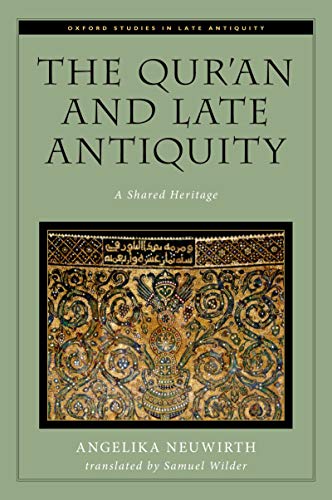
- How the Qur’an Has Been Read So Far: A Sketch of Research
- The Qur’an and Scripture
III. The Qur’an and History
- Redaction and the History of the Text
- Sura Structures and Chronology
- The Liturgical Qur’an: On the Development of Cult at the Time of the Preaching
VII. Stages of Communal Formation in the Early Meccan Period
VIII. Stages of Communal Formation in the Middle and Late Meccan Periods
- Stages of Communal Formation in Medina
- Qur’an and Bible
- Biblical- Qur’anic Figures
XII. The Qur’an and Poetry
XIII. The Rhetorical Qur’an
_________________________________________
বই-
The Qur’an in its historical context
G.S. Reynolds( Editor)
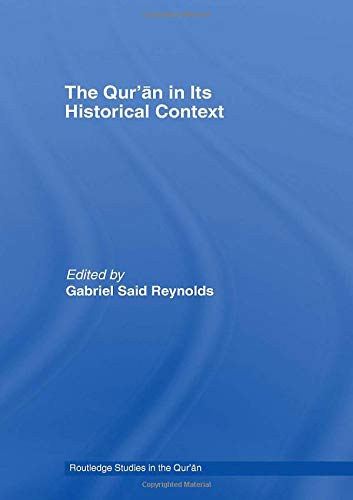
Introduction : Qur’anic Studies and its Controversies. G.S. Reynolds
Part 1 : Linguistic and Historical Evidence
- The Qur’an in Recent Scholarship – Challenges and Desiderata . F. Donner
- Epigraphy and the Linguistic Background to the Qur’an . R. Hoyland
- Reconstructing the Qur’an : Emerging Insights . G. Böwering
- Reconsidering the Authorship of the Qur’an. Is the Qur’an Partly the Fruit of a Progressive and Collective Work ? . C. Gilliot
- Christian Lore and the Arabic Qur’an : The “Companions of the Cave” in Surat al-Kahf and in Syriac Christian Tradition. S. Griffith
Part 2 : The Religious Context of the Late Antique Near East
- The Theological Christian Influence on the Qur’an : A Reflection . S.K. Samir
- Mary in the Qur’an : A Reexamination of Her Presentation. S.A. Mourad
- The Legend of Alexander the Great in the Qur’an 18:83-102 . K. van Bladel
- Beyond Single Words : ma’ida – Shaytan – jibt and taghut. Mechanisms of Translating the Bible into Ethiopic (Ga’az) Bible and of Transmission into the Qur’anic Text. M. Kropp
- Nascent Islam in the 7th Century Syriac Sources. A. Saadi
Part 3 : Critical Study of the Qur’an and the Muslim Exegetical Tradition
- Notes on Medieval and Modern Emendations of the Qur’an . D. Stewart
- Syriac in the Qur’an : Classical Muslim Theories. A. Rippin.
Bibliography. Index of Biblical Verses. Index of Qur’anic Verses. Index of People, Places and Subjects
_________________________________________
বই –
New Perspectives on the Qur’an
The Qur’an in its Historical Context 2
Edited By Gabriel Said Reynolds
Foreword. Abdul Karim Soroush
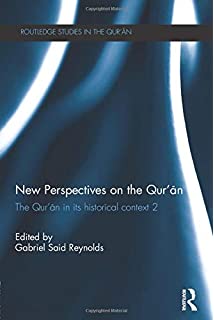
Introduction. Gabriel Said Reynolds
Part 1: Method in Qur’ānic Studies
- The Historian, The Believer, and the Qur’ān. Fred Donner
- Studies in Qur’ānic Vocabulary: The Problem of the Dictionary. Andrew Rippin
- Towards Understanding the Qur’ān’s Worldview: An Autobiographical Reflection. Nasr Abu Zayd
Part 2: The Qur’ān and Material Evidence
- The Jews of the Hijaz in the Qur’ān and in Their Inscriptions . Robert Hoyland
- The Usage of Ancient South Arabian and other Arabian Languages as an Etymological Source for Qur’ānic Vocabulary . Hani Hayajneh
- Vowel Letters and Ortho-epic Writing in the Qur’ān Gerd-R. Puin Part 3: Qur’ānic Vocabulary
- Hapaxes in the Qur’ān: Identifying and Cataloguing Lone Words (and Loan Words) . Shawkat M. Toorawa
- Tripartite, but Anti-Trinitarian Formulas in the Qur’ānic Corpus, Possibly Pre-Qur’ānic. Manfred Kropp
- Angels, Stars, Death, the Soul, Horses, Bows – or Women? The Opening Verses of Qur’ān 79. Munther Younes
- Al-Najm (Q 53), Chapter of the Star: A New Syro-Aramaic Reading of Verses 1-5. Christoph Luxenberg
Part 4: The Qur’ān and Its Religious Context
- Al-Nasārā in the Qur’ān: A Hermeneutical Reflection. Sidney Griffith
- The Mysterious Letters and Other Formal Features of the Qur’ān in Light of Greek and Babylonian Oracular Texts. Devin Stewart
- Does the Qur’ān Deny or Assert Jesus’ Crucifixion and Death? . Suleiman Mourad
- Early Christian Arabic Texts: Evidence for non-Uthmānic Qur’ān Codices, or Early Approaches to the Qur’ān? . Clare Wilde
- Has God Sent a Mortal as a Messenger?” (Q 17:95). Messengers and Angels in the Qur’ān. Gerald Hawting
Part 5: The Qur’ān and Biblical Literature
- Is There a Notion of “Divine Election” in the Qur’ān? . Reuven Firestone
- Lot’s Daughters in the Qur’ān: an Investigation Through the Lens of Intertextuality. Waleed Ahmed
- Joseph among the Ishmaelites: Q 12 in Light of Syriac Sources. Joseph Witztum
- Condemnation in the Qur’ān and the Syriac Gospel of Matthew . Emran El-Badawi
- The Qur’ānic Pharaoh. Adam Silverstein
_________________________________________
বই
The Qurʾān in Context: Historical and Literary Investigations into the Qurʾānic Milieu
Editors: Angelika Neuwirth, Nicolai Sinai and Michael Marx
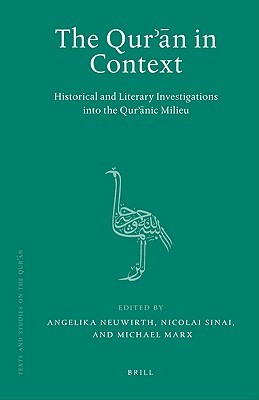
Introduction / Nicolai Sinai, Angelika Neuwirth
Part One : The Qur’an’s Historical Context
The Martyrs of Najran and the End of the Himyar : On the Political History of South Arabia in the Early Sixth Century. Norbert Nebes
Arabia in Late Antiquity : An Outline of the Cultural Situation in the Peninsula at the Time of Muhammad. Barbara Finster
Mecca on the Caravan Routes in Pre-Islamic Antiquity. Mikhail D. Bukharin
Early Islam in the Light of Christian and Jewish Sources. Harold Suermann
The Evolving Representation of the Early Islamic Empire and its Religion on Coin Imagery. Stefan Heidemann
Arabo-Aramaic and `Arabiyya : From Ancient Arabic to Early Standard Arabic, 200 CE-600 CE. Ernst Axel Knauf
Literacy in Pre-Islamic Arabia : An Analysis of the Epigraphic Evidence. Peter Stein
Arabs and Arabic in the Age of the Prophet. Jan Retso
Sources for the History of Pre-Islamic Religion. Tilman Seidensticker
The `Ibad of al-Hira : An Arab Christian Community in Late Antique Iraq. Isabel Toral-Niehoff
An Early Christian Arabic Account of the Creation of the World. Kirill Dmitriev
The Qur’an and the Prophet’s Poet : Two Poems. Agnes Imhof
Part Two : Contextualizing the Qur’an
The Qur’an as Process. Nicolai Sinai
Quantitative Text Analysis and Its Application to the Qur’an : Some Preliminary
Considerations. Nora K. Schmid
Al-Hawamim : Intertextuality and Coherence in Meccan Surahs. Islam Dayeh
The House of Abraham and the House of Amram : Genealogy, Patriarchal Authority, and Exegetical Professionalism. Angelika Neuwirth
Glimpses of a Mariology in the Qur’an : From Hagiography to Theology via Religious-Political Debate Michael Marx
The “Seal of the Prophets’’ : Towards an Understanding of Muhammad’s Prophethood. Hartmut Bobzin
Reading the Qur’an as Homily : The Case of Sarah’s Laughter. Gabriel Said Reynolds
The Qur’anic Commandment of Writing Down Loan Agreements (Q 2:282)—Perspectives of a Comparison with Rabbinical Law. Reimund Leicht
Islam in its Arabian Context . Francois de Blois
Lost in Philology ? The Virgins of Paradise and the Luxenberg Hypothesis. Stefan Wild
The Etymological Fallacy and Qur’anic Studies : Muhammad, Paradise, and Late Antiquity.
Walid A. Saleh
The Relevance of Early Arabic Poetry for Qur’anic Studies Including Observations on Kull and on Q 22:27, 26:225, and 52:31 . Thomas Bauer
Qur’anic Readings of the Psalms . Angelika Neuwirth
The Codification of the Qur’an : A Comment on the Hypotheses of Burton and Wansbrough. Gregor Schoeler
The Second Masahif Project : A Step Towards the Canonization of the Qur’anic Text. Omar Hamdan
List of Contributors
##
(সংযোজন/বিয়োজন চলবে। )
##
—
বই–পত্র ডাউনলোডের জন্যে কিছু ঠিকানাঃ
ইত্যাদি।
####
(আরো যারা দেখতে চান, তাদের জন্যেঃ
Rain-Giver, Bone-Breaker, Score-Settler : Allāh in Pre-Quranic Poetry। Nicolai Sinai
Unearthing A Pre-islamic Arabian Prophet। Ella Landau-tasseron
READINGS IN LATE ANTIQUITY A Sourcebook .Michael Maas
The World of Late Antiquity । Peter Brown
Late Antiquity on the Eve of Islam । Averil Cameron
The Golden Calf between Bible and Qur’an: Scripture, Polemic, and Exegesis From Late Antiquity to Islam. Michael E. Pregill
The Origins Of Muslims Prayer: Sixth And Seventh Century Religious Influences On The Salāt Ritual . Justin Paul Hienz
Pre-Islamic Arabia and Early Islam. Ilkka Juhani Lindstedt
Arabia And The Arabs : From The Bronze Age To The Coming Of Islam. Robert G. Hoyland
Arabia( ( in The New Cambridge History of Islam)। Ella Landau-tasseron
Arabia In Late Antiquity: An Outline Of The Cultural Situation In The Peninsula At The Time Of Muhammad। Barbara Finster
Seeing Islam As Others Saw It: A Survey And Evaluation Of Christian, Jewish And Zoroastrian Writings On Early Islam . Robert G. Hoyland.
The Nativist Prophets of Early Islamic Iran: Rural Revolt and Local Zoroastrianism। Patricia Crone
From Tribal Society To Centralized Polity: An Interpretation Of Events And Anecdotes Of The Formation Period Of Islam. Ella Landau-tasseron
Philosophy in the Islamic World Online: 8th-10th Centuries.Edited by Ulrich Rudolph, Rotraud Hansberger and Peter Adamson
The Rebel and the Imām in Early Islam: Explorations in Muslim Historiograph. Najam Haider
#
ইসলাম, সমাজ– রাজনীতি– সংস্কৃতি, ইতিহাস, বিশ্বরাজনীতি, ধর্মতত্ত্ব–সব সম্পর্কে পর্যালোচনামুলক পাঠের জন্যে বিস্তারিত একটা তালিকা দেখুনঃ
‘দ্বীন ও দুনিয়া (ইসলাম সম্পর্কে পর্যালোচনামুলক পাঠের একটা তালিকা)।। অরূপ রাহী
সেক্যুলারিজম বিতর্কঃ একটা পাঠসুত্র ।। অরূপ রাহী
দ্বীন, ধর্ম ও উপাসনা অধ্যয়ন সম্পর্কে বিস্ত্যারিত পাঠের জন্যে একটা পাঠতালিকা পাইতে নজর রাখেনঃ https://www.lokayoto.org/
#####################################################################
কপি সম্পাদনাঃ মোহাইমিন লায়েছ ।

